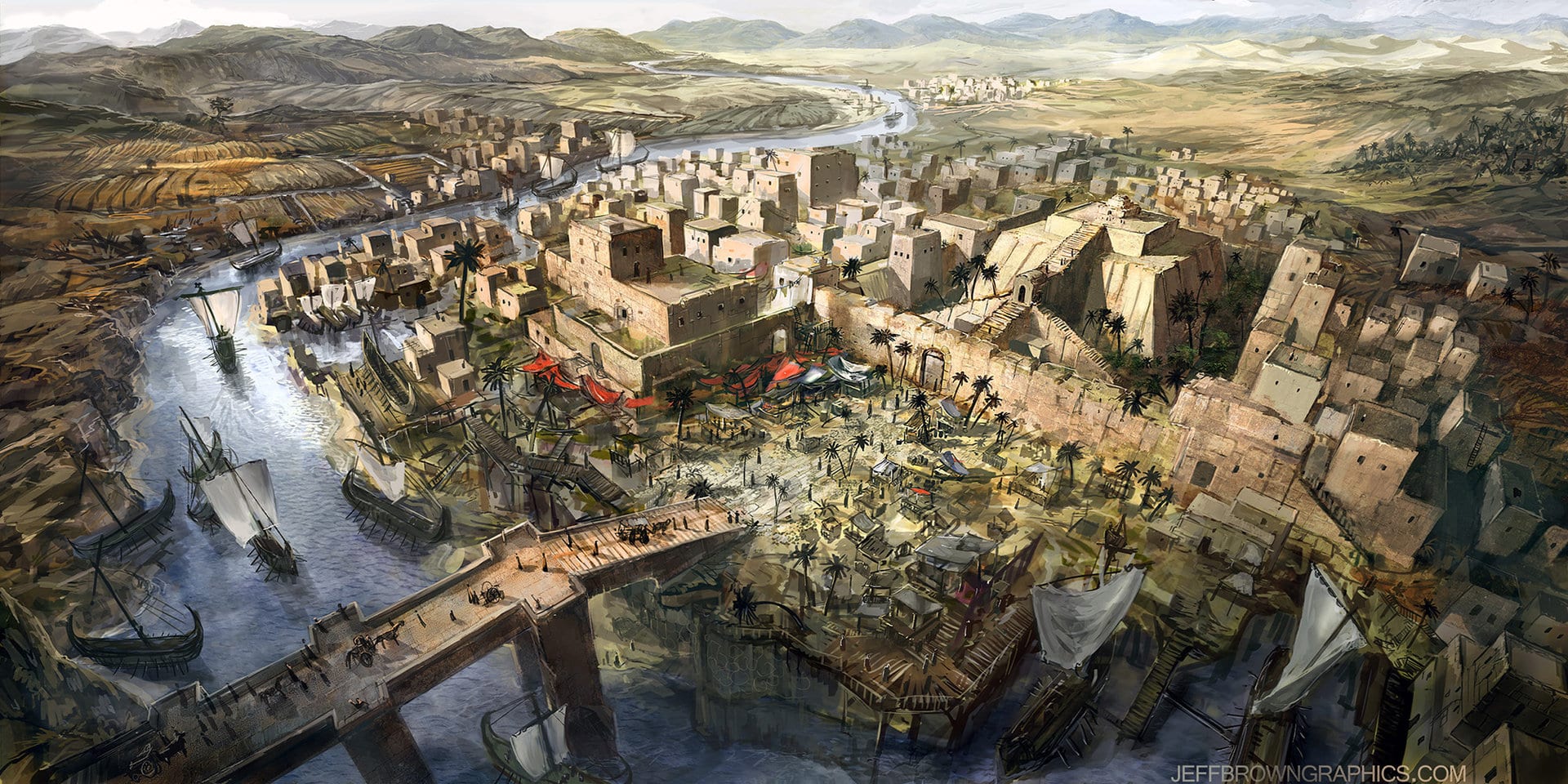
The Mesopotamian civilization developed between the Trigris and Euphrates rivers, whose waters were the means of irrigation for the fields. They are territories that we can currently locate on the map in the Middle East area. Over the years, they have seen how new prosperous civilizations have emerged for the development of humanity. This culture were the forerunners of techniques such as the plow, they knew the roads with four-wheel vehicles and the sailboat.
The name of Mesopotamia has been translated into different ancient languages that existed at that time and comes to mean, between two rivers. This is due to the geographical situation where they were located. Don't you know all the history behind the Mesopotamian civilization? Do not wait a second longer and enter this new world.
Historical facts about the Mesopotamian civilization
The Mesopotamian civilization arises around the 4000 BC century and in it, the first permanent settlements are developed. It was located in an area whose land was very fertile between two rivers, the Tigris River and the Euphrates, what we know today on the map as the region of Iraq. The name of this region comes from this area where they settled as we mentioned at the beginning, being between two bodies of water, the name of Mesopotamia is defined as "land between rivers".
Egypt and Greece were two civilizations that had a parallel development, that is, it was little by little and in a more isolated way than the rest. The Mesopotamian civilization was characterized by hosting different empires and cultures that were undergoing a joint evolutionHence, Mesopotamia is considered the cradle of civilization.
There were four, the main cultures that stood out in this stage of history, the Sumerian civilization, the Akkadian, the Assyrian and the Babylonian.. They are responsible for the creation of new agricultural techniques in order to take advantage of the floods suffered by the rivers in times of abundant rainfall, which helped them create cities with a greater number of populations.
Mesopotamian civilization: origin
If we focus on the origin of the civilization that we are talking about in this publication, we have to go back to the historical stage of prehistory, at the end of the Neolithic period. This stage was characterized by the way of life that the human species had, in small groups and dedicated mainly to hunting or gathering food.
The civilization knew how to take advantage of its location between two rivers to use that water as food for its plantations., so agriculture was developing and the same happened with livestock, being able to generate food for both the population and the animals.
Over time, Mesopotamian civilization evolved and began to form the first settled peoples. This event marked a before and after for them and for history, which was developed throughout the map until reaching the current world.
Major rivers of the Mesopotamian civilization
As we have been commenting, The main rivers that bathed the cultivation fields of this civilization were two, the Tigris River and the Euphrates. Thanks to them, prosperity was possible in the Mesopotamian peoples.
- Tigris River: It has a total length of 1850 kilometers. One of the characteristics of this river is its great slope, from its birth point to its mouth it has a 1150 m drop.
- euphrates river: a total extension of 2800 km is what this river has. It has a drop of more than 4 thousand meters, but with a smooth route throughout its entire length. Some of its tributaries such as the Taurus, Balih and Habur cross what is the ancient territory occupied by the Mesopotamian civilizations.
Both rivers during the time of Mesopotamia suffered constant floods, which helped to fertilize the cultivated land of civilizations.
Main characteristics of the Mesopotamian civilization

history.nationalgeographic.com.es
The Mesopotamian civilization had a series of characteristics by which it could be said that they were represented, then we will discover them for you.
- All the agriculture and livestock activities were the main and, food gathering and hunting were left in the background
- The social structure that had been created had a dense population and was organized by families and also by division of labor
- All the own cultures of this civilization crossed with others close as they were, Egypt or the Indus Valley
- La variety of cultures that populated it: Sumerians, Arcadians, Assyrians and Babylonians
- Se developed knowledge about mathematics, astronomy and architecture. The first cuneiform writing system appears
- They created one of first legal documents written with laws on stone and tablets of clay material, this occurs during the time that the Babylonians inhabited
- The present religion was polytheistic, so different gods were worshiped, each with a temple and certain worship rituals
Contributions left by the Mesopotamian civilization
We are not only going to explain to you what the Mesopotamian civilization is and its main characteristics, but also We are going to accompany you to discover what were the main contributions of this civilization.
- Writing system: the first traces of writing are found, it should be noted that they predate the Egyptian system of hieroglyphs. This writing was called cuneiform because of its wedge shape.
- Calendar: a Mesopotamian calendar that represented the two seasons of the time; summer and winter.
- law code: laws in the Semitic language that were written on a stone or clay tablets. In them, annotations of punishments for criminals always based on their social class appeared.
- Astronomy: The data that has been discovered throughout history shows that it was a civilization that believed in a planetary system and that, in addition, the planet earth rotated on another luminous one.
Mesopotamian cultures

culturecientifica.com
The region of Mesopotamia was divided into different peoples; to the north were the Assyrians and to the south the Babylonians. The latter covered two more territories, in the upper part was Acadia and in the lower part, Sumeria. As we have just mentioned, the Mesopotamian cultures were varied and managed to differentiate one from another not only because of their origin but also because of the lifestyle that each one led. It is time to discover what the main Mesopotamian cultures were based on.
The Sumerians
We are talking about the first civilization in the Mesopotamian region, they founded the first cities such as Uma, Ur, Eridu and Ea. Although you may be surprised to read this, during this stage of history you already had an idea of what the State meant not only as a social model but also as a political one. It must be said that it was an old way of understanding, but in it a figure reigned whose power was absolute over the people.
The first pictograms date from this stage, which would mean the origin of writing. The technique they used was to assign a word to a drawing. The development of buildings as important as temples or walls, were essential for the development and protection of cities.
the akkadians
As has always happened throughout history, events that are not as desired as invasions happen. Various nomadic peoples; Syrians, Hebrews and Arabs invaded the territories already developed by the Sumerian culture. This event is around the 2500 century BC
The Akkadian civilization was the most important group in the Mesopotamian region due to King Sargon. This figure was the one who founded the capital of Agade when the Lugalzagesi empire was defeated. Some time later, this king had to face different conflicts due to the power struggle, a fact that caused the fall of the Akkadian empire in 2200 BC.
The Assyrians and Babylonians
There was a brief reconquest by the Sumerians, to the lands that the Akkadians had taken from them. The Babylonian and Assyrian empires were among the most important and influential in the Mesopotamia region. Thanks to them, a new model of united empire was created that was taken by other modern monarchs in Western Europe.
Under the power of Hammurabi, the struggle to achieve the extension of the territory and a cultural dominance began, thus making Babylon the capital. During this stage, the first laws on a prosperous administrative system were written, this occurred as a result of the fact that the empire had a lot of domain and it needed to be controlled.
During this time the importance of this empire stands out and this is because of great military practices with which it had the people under control. They were characterized by being relentless, by not letting anything or anyone overcome them, they devastated everything they saw and imposed their rules and their culture. It should be noted that this culture introduced new forms of irrigation, in addition to an important cultural legacy that has survived to the present day.
What do you think of everything we have taught you about this civilization? Did you find it interesting and did you learn something new? We have helped you to understand in a deeper way what the Mesopotamian civilization is, where we can locate it on the map, why they were so important in history and what cultures inhabited them. As we have told you, we hope that this publication has been of interest to you, and that from now on if someone asks you about this topic, you will know how to explain things as interesting as the ones we have explained to you today.